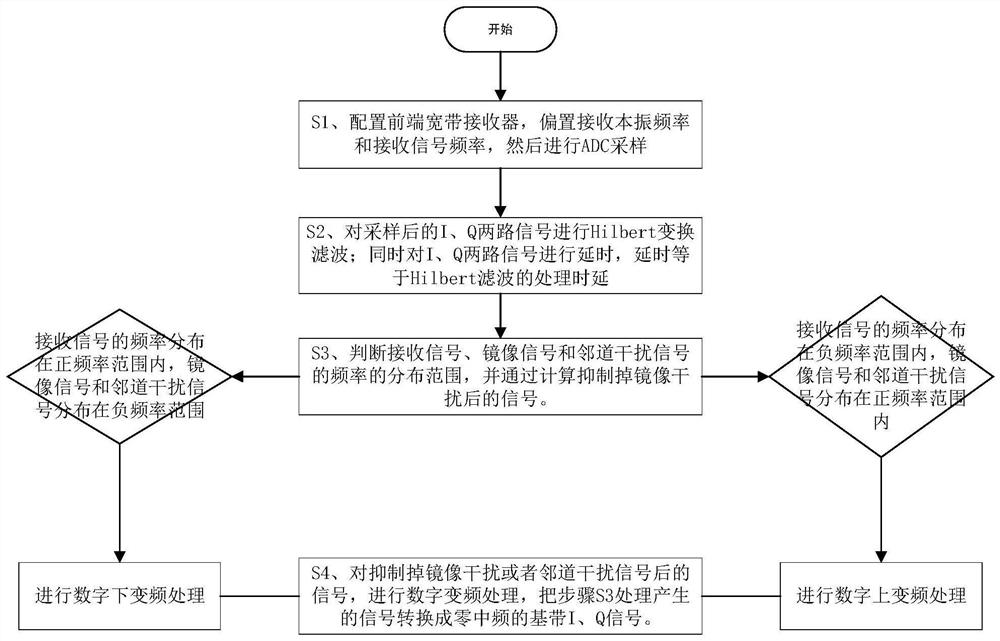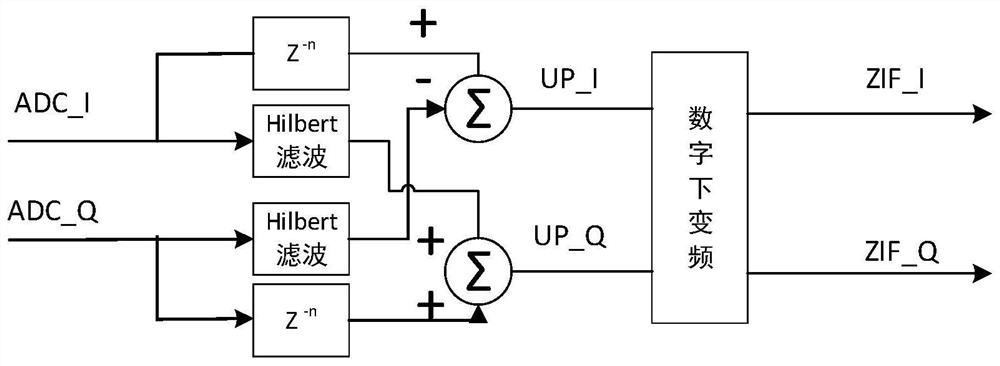Baseband Signal Image Interference Suppression Method
A technology of image interference and baseband signal, applied in transmission systems, electrical components, etc., can solve problems such as image interference, and achieve the effect of suppressing interference, easy to implement, and suppressing image interference
- Summary
- Abstract
- Description
- Claims
- Application Information
AI Technical Summary
Problems solved by technology
Method used
Image
Examples
Embodiment 1
[0029] Embodiment one is basically as attached figure 1 Shown: baseband signal image interference suppression method, comprising the following steps:
[0030] S1. Configure the front-end broadband receiver, bias the receiving local oscillator frequency and the receiving signal frequency, and separate the image interference signal into positive and negative frequencies. For example, the receiving signal is at the positive frequency, and the image signal is at the negative frequency, that is, the two sides of the zero intermediate frequency, and then Take ADC sampling.
[0031] The bias frequency must meet the following conditions at the same time:
[0032] S11. The zero-IF sampling image signal and the received baseband signal are respectively distributed in positive and negative frequency ranges.
[0033] S12. The sampled baseband received signal is within the sampling frequency range, and frequency aliasing will not occur.
[0034] S2. Perform Hilbert transform filtering o...
Embodiment 2
[0048] Compared with Embodiment 1, the difference is that: for suppressing adjacent channel interference, the specific steps are as follows:
[0049] S1. Configure the front-end wideband receiver, offset the receiving local oscillator frequency and the receiving signal frequency, and separate the adjacent channel interference signal into positive and negative frequencies. For example, the receiving signal is at the positive frequency, and the adjacent channel signal is at the negative frequency, that is, both sides of the zero intermediate frequency. , followed by ADC sampling.
[0050] The bias frequency must meet the following conditions at the same time:
[0051] S11. The zero intermediate frequency sampling adjacent channel signal and the received baseband signal are respectively distributed in positive and negative frequency ranges.
[0052] S12. The sampled baseband received signal is within the sampling frequency range, and frequency aliasing will not occur.
[0053] ...
PUM
 Login to View More
Login to View More Abstract
Description
Claims
Application Information
 Login to View More
Login to View More - R&D
- Intellectual Property
- Life Sciences
- Materials
- Tech Scout
- Unparalleled Data Quality
- Higher Quality Content
- 60% Fewer Hallucinations
Browse by: Latest US Patents, China's latest patents, Technical Efficacy Thesaurus, Application Domain, Technology Topic, Popular Technical Reports.
© 2025 PatSnap. All rights reserved.Legal|Privacy policy|Modern Slavery Act Transparency Statement|Sitemap|About US| Contact US: help@patsnap.com



